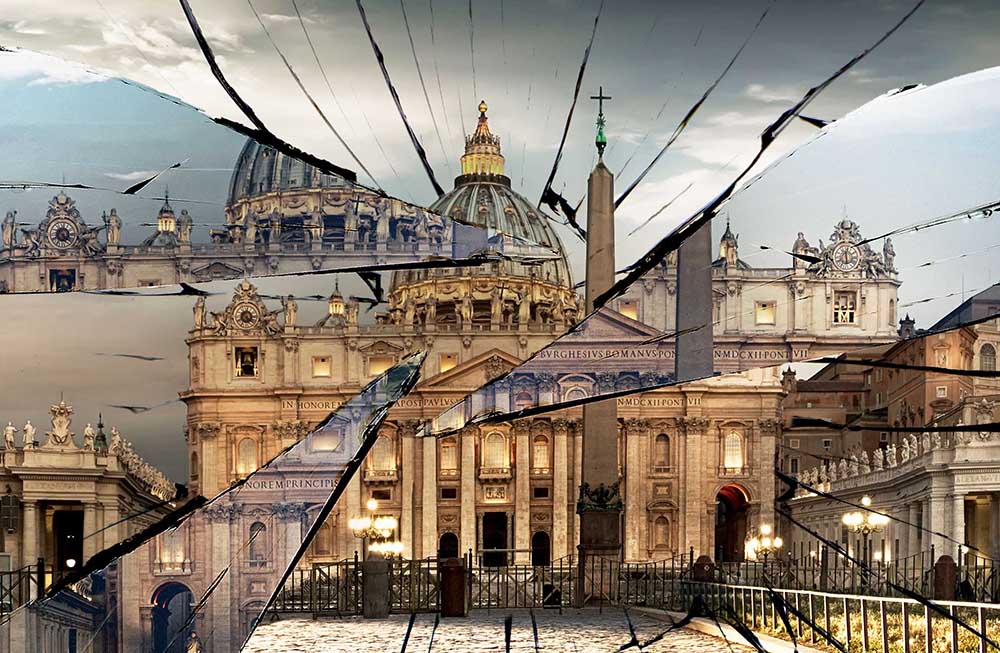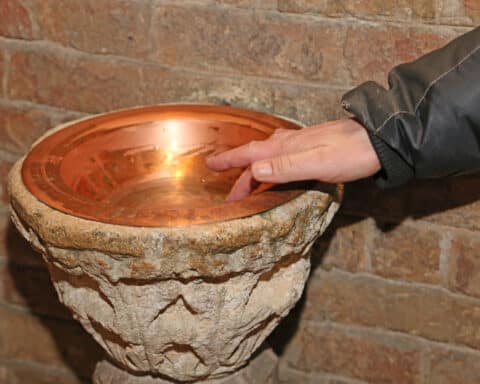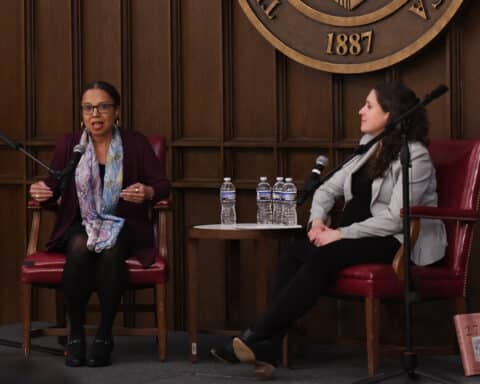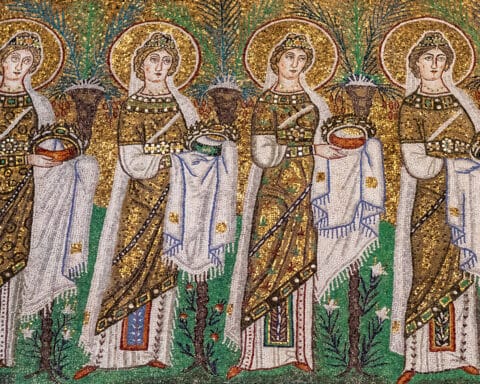As Catholic Christians, we are taught to forgive others, to reconcile with our neighbor, to seek out amicable ways to end grudges and angry separations; yet we have been part of a grudge that has festered for nearly a thousand years. The Roman Catholic Church of the West and the Orthodox Church of the East have an ongoing rift that can be traced to the 11th century: the Great Schism.
Roots of the schism
A schism is the purposeful separation from the unity of the Church, the refusal to recognize the authority of the pope and can result in excommunication.
The Great East-West Schism had its beginning in A.D. 330 when Emperor Constantine (r. 306-37) decided to move the capital of the Roman empire from Rome to a site on the European side of the Bosporus Straits (now Turkey), an ancient Greek settlement called Byzantium. Here, he had a perfect port on a key waterway that connected East and West, a place of thriving commerce and a strategic military location. Relocating the capital out of Rome would eventually lead to political, culture and religious controversies between the Catholic Church of the East and West.
Constantinople
For his capital city, Constantinople, Emperor Constantine wanted a religious leader that would have the same status as the bishops of Rome, Alexandria, Jerusalem and Antioch. Such action was not widely accepted by bishops or patriarchs in those locations, especially in Rome. There was no recognized pope at the time, rather each of the bishops were equal in status, with the bishop of Rome considered first among equals. The frequent effort to elevate the patriarch of Constantinople to a stature equal to the bishop of Rome was never accepted by the West. While the issue of pope and papal authority would become a constant rub between religious leaders in the East and West, there were other differences that contributed to the Great Schism.
First ecumenical councils
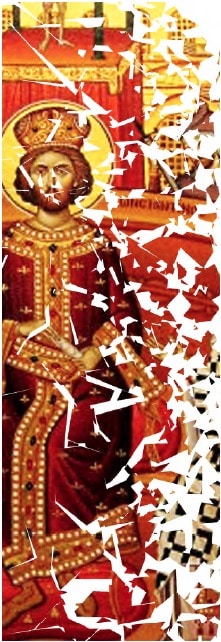
A year after his move to Constantinople, Emperor Constantine called a general (ecumenical) council of all the Church bishops. This council held at Nicea (Turkey) in A.D. 325 was the first of 21 ecumenical councils throughout Church history. The first eight ecumenical councils were called by the emperor or empress, and only the initial seven councils were acknowledged by the then Eastern Churches. The pope has called all such councils beginning since 1123, and the Orthodox Church continues to deny the legitimacy of those councils pointing to the lack of authority of the pope.
At the Council of Nicea, the bishops dealt with the Arianism heresy and clearly dismissed the claim that the Son (Jesus) was inferior to the Father (God). The council said in the Nicene creed, which they subsequently issued, that the Son was consubstantial (equal) with the Father. This council also established the date of Easter, which had been greatly contested.
The Nicea Council did not address the Holy Spirit. Nearly 60 years later, Emperor Theodosius I (r. 379-95) called another ecumenical council to affirm the results of Nicea and to proclaim the divinity of the Holy Spirit. In a slap at the papacy, Theodosius invited 150 Eastern bishops to Constantinople (Constantinople I) but did not inform the bishop of Rome, Pope St. Damasus I (r. 366-84), until near the start of the council in 381. Thus, the West was not represented, and at first Rome would not accept the council decisions, but, later in history, the council was accepted as ecumenical.
At Constantinople, the bishops attending confirmed the decisions made at Nicea and acknowledged the divinity of the Holy Spirit as equal to the Father and the Son. They amended the Creed to make their point, writing: “…And the Holy Spirit, the Lord and giver-of-life, who proceeds from the Father, who with the Father and the Son together is worshiped and glorified, who has spoken through the prophet.” This addendum did not say that the Holy Spirit proceeds from the Father and the Son, which was a problem throughout Church history.
At the Council of Ephesus in 431, the bishops declared that no new creeds would be issued, and at Chalcedon, 451, the bishops read out both the original creed from Nicea and from Constantinople. Historians conclude that the reading of both creeds indicates that the Western Church accepted the results of the first Council of Constantinople — meaning the Church was confirming that the Holy Spirit proceeded from the Father, alone.
The ‘filioque’
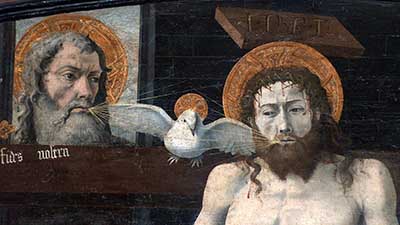
In sixth century Spain, and emanating from a national council, the bishops began using the words “and from the Son” when praying the creed. These words in Latin are called filioque. The insertion of the filioque into the creed was used throughout Spain and slowly adopted by other Western countries. At first the popes refused to make this insertion universal. In fact, Pope Leo III (r. 795-816) had the Nicene-Constantinopolitan Creed, without the filioque, inscribed on plaques and placed in (Old) St. Peter’s Basilica. It was Pope Benedict VIII (r. 1012-24) in the 11th century, succumbing to political pressure, who added the creed, including the filioque into the Mass. This met with a quick response from the Eastern Catholics who said changing the creed could not be done without universal Church approval. At the Second Ecumenical Council of Lyon in 1274, the bishops attending, including representatives of the Eastern Churches, issued a constitution stating that the “holy spirit proceeds from the Father and the Son” and condemned those who professed differently. The Byzantine leadership, despite agreement by their council attendees, rejected this decision.
Other issues causing controversies
Early on in the Church, following the controversy over Arianism, there was a debate about the person of Jesus. In the East, there were some who claimed that Christ was divine only and had no human nature. The West rejected this idea as another Eastern heresy. Known as Monophysitism, the belief was officially condemned at the Council of Chalcedon in 451. Unfortunately, there were Eastern churches and individuals that refused the council results. At another council, Constantinople III in 681, the bishops condemned Monophysitism and any bishop living or dead that supported it. For the most part, this brought an end to the heresy.
In the eighth century, Byzantine Emperor Leo III (r. 717-41) ordered the destruction of all icons, pictures and religious images in every church. Such action, known as Iconoclasm, is believed to have resulted from the increase of Muslims seeking to convert to Christianity as well as other Christians who saw images as a form of idolatry. Pope St. Gregory III (r. 731-41) refused to comply, and the emperor made a failed attempt to arrest the pope. The Council of Nicea II in 787 formally denied the removal and destruction of icons and other images. The council bishops were fully cognizant that veneration of icons had been going on for years and as such were important in teaching a populace that was mostly illiterate. The iconoclast controversy finally ended in 843 but had created added tension between East and West.
Celibacy of priests was and continues to be another difference. The Church in the East believes that it is permissible for priests to be married prior to ordination, the West does not. The West uses unleavened bread for the Eucharist, the East uses leavened. The sign of the cross is made differently. Then as now, the West believes in purgatory, the East does not. Then there is the issue of papal authority.
The Orthodox Church does not accept that the pope is the head of the Church. They consider his authority only equal to that of other leaders (bishops or patriarchs) of the five patriarchal sees: Rome, Constantinople, Alexandria, Antioch and Jerusalem. The bishop of Rome has long been given senior status among the bishops, but the Orthodox Church denies that he has special or unilateral authority over others. This issue was exacerbated during the Ecumenical Council of Vatican I, 1869-70, when the attendees identified the pope, in certain situations dealing with faith and morals, as infallible.
The schism begins
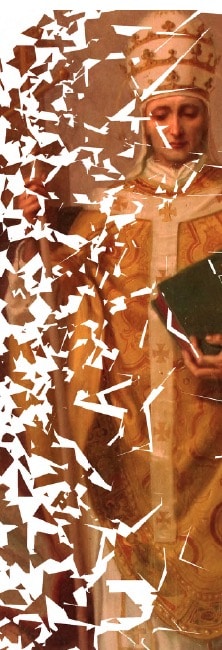
The Great Schism between the Churches of East and West began in July 1054. During the reign of Pope Leo IX (1049-54), the Roman Church interfered with the Byzantine Churches located in southern Italy. The pope ordered those churches to use unleavened bread and include the filioque clause in the Creed. Michael Cerularius (r. 1043-58), the Patriarch of Constantinople, objected saying the pope had no authority for such action and made his point by closing the Latin Rite churches in Constantinople. He also wrote a letter to the churches in Italy to continue their traditional practices. Becoming aware of Cerularius’ reaction, Pope Leo dispatched emissaries to Constantinople headed by Archbishop Humbert in an attempt to discuss the difficulties. Both Cerularius and Humbert were strong personalities, stiff necked, uncompromising, and the possibility of a good conclusion quickly evaporated. Cerularius ignored the envoys; Humbert excommunicated Cerularius and his staff and posted the bull of excommunication in the church of Hagia Sophia. In return, Cerularius excommunicated the papal envoys. This was the beginning of the schism; Church oneness was shattered. Some at the time did not think this problem would be long term; unfortunately, it is still not totally resolved.
Before the schism, there was one Catholic Church made up of Catholics living in the eastern and western parts of the Roman Empire. Following the schism, those in the East called themselves Orthodox Christians and, in the West, Catholics. Eventually Catholics in the West became known as Roman or Latin Catholics. As centuries went by, 23 of the Orthodox Churches reunited with Rome and are called the Eastern Catholic Church. These Catholics accept the authority of the pope (Code of Canons Eastern Church No. 43). Today they have an estimated 18 million members while the Orthodox Church membership exceeds 220 million. Total Eastern Catholics and Western Catholics is over 1.3 billion.
Crusades impact the schism
From 1095 until 1270, there were seven crusades (invading armies) launched by the Holy See, first against the Turks and later Egyptian Muslims who occupied the Holy Land, the lands where Christ lived and taught the Gospel. The crusading armies attacked Jerusalem in 1099 and Constantinople in 1204. Both cities were filled with Christians, many of whom were murdered, without cause, by the Western armies. After sacking Constantinople, the crusaders, instead of returning the city to the Byzantine empire, established one of their own as king. Although the pope did not condone these acts, the atrocities would long be remembered in the East and impact the success of reconciliation efforts.
Despite the many differences there have been and continue to be between East and West, there have been efforts to unite the Church.
Councils in the Middle Ages and attempted reconciliation
During the Middle Ages, there were two ecumenical councils that addressed reconciliation: Lyons II, 1274, and Florence, 1438-45. Attendees at both councils signed agreements that should have had a positive impact on the East-West differences, but in both instances, after the fact, the Greek bishops rejected the agreements. Florence was especially notable and reflects the attitudes of the time.
By the beginning of the 15th century, the Ottoman Turks were overrunning the Byzantine empire and closing in on Constantinople. There was no way the Greeks could stop the Turks’ takeover without help. So, Emperor John VIII Palaiologos (r. 1425-48) sought military and economic assistance from the Western Church. The emperor, along with Constantinople Patriarch Joseph II (r. 1416-39), knew that assistance from the West would have to be preceded by a compromise of the differences between the Eastern and Western churches.
Eventually, political and religious leaders from East and West met at Florence, Italy, in 1438 with the primary intention of reunion between the two churches. From the beginning this was not an ideal council. Arriving in Italy, Patriarch Joseph was told that he was expected to kiss the shoe of Pope Eugenius VI (r. 1431-47) at their initial meeting. Joseph refused. The seating arrangement during the council sessions provided the pope with an elevated and more ostentatious seat than that for the Greeks. While the pope had agreed to pay all expenses for the visitors, including day to day living needs, such payments seemed to be always late and sometimes with stipulations. Despite the tension, attendees did find compromise solutions for the issues of the filioque, communion bread, purgatory and papal supremacy. An agreement was signed, but many of the Eastern churches refused to accept the agreements, and Emperor John became very unpopular. In less than six months, the Turks captured Constantinople. The patriarch of Constantinople installed by the Turks rejected all the agreements from the Council of Florence. Everything was pretty much back to square one, and the next meeting between the pope and the Constantinople patriarch, East and West, was over 500 years away.
| Pope St. John Paul II’s commitment to ecumenism |
|---|
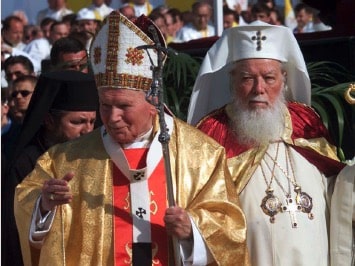 Pope St. John Paul II (r. 1978-2005) pointed out likely difficulties in East -West unity in his May 1995 encyclical, Ut Unum Sint (“That They May Be One: On Commitment to Ecumenism”). The Holy Father said that any progress toward unity of the two Churches must be tempered with an understanding of “…long-standing misgivings inherited from the past and the mutual misunderstandings and prejudices. Complacency, indifference and insufficient knowledge of one another often make this situation worse. Consequently, the commitment to ecumenism must be based on the conversion of hearts and upon prayer, which will also lead to the necessary purification of past memories” (No. 2). In this beautifully worded encyclical, Pope John Paul II asks, “How can unity be restored after almost a thousand years? This is the great task which the Catholic Church must accomplish, a task equally incumbent on the Orthodox Church. Thus can be understood the continuing relevance of dialogue, guided by the light and strength of the Holy Spirit” (No. 61). He points out the role of the pope and the Church: “The bishop of Rome must ensure the communion of all the churches, for this reason he is the first servant of unity” (No. 94). He continues: “The Catholic Church … holds that the communion of particular churches with the Church of Rome, and their bishops with the bishop of Rome is — in God’s plan — an essential requisite of full and visible communion” (No. 97). Unity and end of the schism “is in God’s plan.” Pursuit of reconciliation continues. |
Vatican II
Pope St. John XXIII (r. 1958-63) is the catalyst for 20th and 21st century efforts at reconciliation between the churches. He called for the Second Vatican Council (1962-65), which included the framework proposed to bring an end to the long estrangement not only between East and West but other non-Catholic, separated churches as well. The council Fathers responded with a document, Unitatis redintegratio (“Decree on Ecumenism”), stating: “The restoration of unity among Christians is one of the principal concerns of the Second Vatican Council” (No. 1).
In Chapter 3 of this decree, the bishops address “The Special Consideration of the Eastern Church,” saying, “To remove, then all shadow of doubt, this holy Council solemnly declares that the Churches of the East, while remembering the necessary unity of the whole Church, have the power to govern themselves according to the disciplines proper to them, since these are better suited to the character of their faithful, and more for the good of their souls” (No. 16).
Emphasis on the importance of churches continuing their traditional practices is also in the Vatican II document, Orientalium ecclesiarum (“The Decree on the Churches of the Eastern Rite”). This attitude of not dismissing but complementing the traditions, custom and culture of others has played a major role in the unity between the now Eastern Catholic Churches and the Church of Rome. Although such unification with the Orthodox Church has not been as rapid, some progress has been made.
Modern-era initiatives at reconciliation
While Vatican II was taking place, for the first time in over 500 years, a pope met with the Ecumenical Patriarch from the Orthodox Church. This meeting took place on the Mount of Olives between Pope St. Paul VI (r. 1963-78) and Constantinople Patriarch Athenagoras on Jan. 5 and 6, 1964. Paul IV reportedly said to the Patriarch that their “unity should not have been broken.” The leaders of the two churches prayed that their encounter would be a prelude to more such meetings and, indeed, every pope since Paul VI has reached out, responded to and met with patriarchs from the Orthodox Church. On more than one occasion, while celebrating Mass with an Orthodox patriarch, different popes have said the creed in Greek and without the filioque.
Historically, the Patriarch of Constantinople has been considered first among the Eastern patriarchs but has influence over far fewer members than the Patriarch of the Russian Orthodox Church that includes over half of all Orthodox Christians. In a complicated series of events, in 2018 the Russian Orthodox Church broke communion with the Patriarch of Constantinople. The Holy See acknowledges the role of the Patriarch of Constantinople while also communicating with the Russian church.
In October 2021, and indicative of the continuous reconciliation efforts being made, Pope Francis had a private session with the members of the St. Irenaeus Joint Orthodox-Catholic Working Group. This group, seeking common solutions to Church division, is part of a larger Joint International Commission for Theological Dialogue Between the Catholic and Orthodox Churches.
During the session, the Holy Father praised the work of the group and touted their identified task: “to seek together ways in which the different traditions can enrich one another without losing their identity.” Francis said, “In this spirit, your discussions center on appreciating how differing aspects present in our traditions, rather than giving rise to disagreements, can become legitimate opportunities for expressing the shared apostolic faith.” Pope Francis told the group that he was going to name the group’s patron saint, St. Irenaeus, a Doctor of the Church (which the Pope did in January 2022). Irenaeus was a product of the Eastern Church, a student of St. Polycarp; he lived much of his adult life in the West where he became the greatest theologian of his time. The pope called him a Doctor of Unity because his life bridges the gap between East and West.
The working group is only one of the many reconciliation efforts since Vatican II, including the Catholic Church Pontifical Council for Promoting Christian Unity, the foundation of which was created by Pope St. John XXIII in his Vatican II initiative. Also, as part of each liturgical year, the Church calls Catholics to an annual week of prayer for Christian unity. This week of prayer begins every Jan. 18.
Given that the East-West schism has lasted close to a thousand years, the reconciliation results over the last 60 years have been monumental: overcoming language barriers, opening lines of communication, forming joint commissions and working groups, exchanging visits and Mass celebrations of the pope and Orthodox Patriarchs — all setting the stage for an ultimate goal of one Church. But this journey is not easy.
D. D. Emmons writes from Pennsylvania.
| Schism (chaos) in the West |
|---|
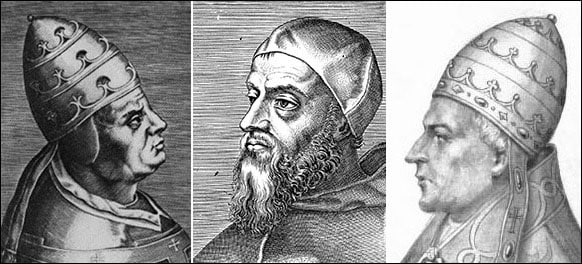 While the Great East-West Schism was taking place, the Roman Church experienced its own internal schism. From 1378 until 1417, there were periods when the Church of Rome had two popes, and, for a short while, three. The events leading to this situation are confusing at best, but in April 1378 the Church cardinals chose Urban VI as pope; almost immediately they regretted their choice. They soon left Rome and in September voted to depose Urban and elected Clement VII. But Urban, who had been duly elected, refused to relinquish his position, and for the next 40 years the Church had two popes. Catholics of the time would suffer not knowing who was the true Holy Father. The author, Clinton Locke, in his book “The Age of the Great Western Schism” (Scribner’s Sons, N.Y., 1910), explained how this situation “tore Christendom into pieces, and dragged the banner of the Prince of Peace in the vilest mud; everywhere hateful words, lies, perjury, trickery, simony, and the grossest and most unblushing immorality on the part of those set highest in the Church.” At the Council of Pisa in 1409, not an ecumenical council, the two reigning popes were deposed but refused to resign. The council attendees elected Alexander V, so there were now three popes. Finally, this all got sorted out when by early 15th century one of the popes had died and the other two resigned. Pope Martin V was elected in November 1417, and the schism in the Western Church was ended. |

